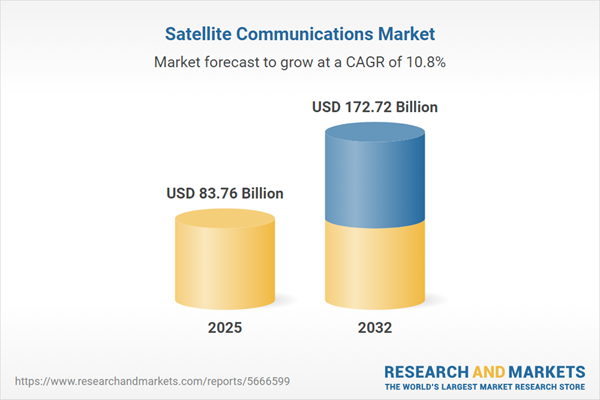Speak directly to the analyst to clarify any post sales queries you may have.
The satellite communications market is undergoing rapid, multi-faceted transformation as organizations worldwide demand agile, high-performance connectivity. Shifts in both satellite and ground network architectures continue to deliver opportunities for commercial, government, and defense stakeholders.
Market Snapshot: Satellite Communications Market Size & Growth
The Satellite Communications Market grew from USD 76.21 billion in 2024 to USD 83.76 billion in 2025. It is projected to expand at a CAGR of 10.76%, reaching USD 172.72 billion by 2032. This sustained growth reflects persistent demand for high-speed data, resilient communications, and integrated network solutions that serve diverse industry applications worldwide.
Scope & Segmentation of the Global Satellite Communications Market
This report provides comprehensive coverage of the satellite communications ecosystem, encompassing key components, technologies, applications, and user groups across all major regions:
- Component Type: Equipment (amplifier, antenna, receiver, transmitter) and Service (broadcasting services, fixed satellite services, managed services, mobile satellite services, transaction services)
- Orbit Type: Geostationary orbit, high Earth orbit, low Earth orbit, medium Earth orbit
- Technology: Ground station equipment, SATCOM equipment, satellite imagery, synthetic aperture radar (SAR), transponders, very small aperture terminal (VSAT)
- Frequency Band: C band, Ka band, Ku band, L band
- Application: Asset tracking/monitoring, broadcasting, data backup and recovery, and voice communication (satellite phones, VoIP services)
- End-User: Commercial, defence, government, maritime, space science, transport
- Market Channel: Direct sales, distributors, e-commerce, retail
- Region: Americas (United States, Canada, Mexico, Brazil, Argentina, Chile, Colombia, Peru), Europe, Middle East & Africa (United Kingdom, Germany, France, Russia, Italy, Spain, Netherlands, Sweden, Poland, Switzerland, United Arab Emirates, Saudi Arabia, Qatar, Turkey, Israel, South Africa, Nigeria, Egypt, Kenya), Asia-Pacific (China, India, Japan, Australia, South Korea, Indonesia, Thailand, Malaysia, Singapore, Taiwan)
- Company Coverage: Includes companies such as Airbus SE, Al Yah Satellite Communications Company PJSC, Eutelsat S.A., EchoStar Corporation, Intelsat US LLC, SES S.A., Viasat, Inc., and others impacting the global landscape.
Key Takeaways for Senior Decision-Makers
- Demand for seamless global connectivity is reshaping satellite network architectures, driving adoption of high-throughput solutions and integrated hybrid models
- Emerging partnerships between satellite and terrestrial network operators are broadening coverage and unlocking new business models for sectors such as maritime, defense, and remote infrastructure management
- Regulatory environments and spectrum management are enabling large-scale satellite constellation deployments, with coordinated orbital debris mitigation and spectrum sharing strategies
- Advances in ground infrastructure and reusable launch technologies are reducing cost barriers, making satellite communication increasingly competitive in previously underserved regions
- Market segmentation underscores the importance of targeted approaches, as needs diverge by component, technology, orbit type, application, and end-user priorities
- Regional dynamics reveal varying rates of adoption and infrastructure investment, with Asia Pacific emergent in digital inclusion initiatives and the Americas advancing LEO network deployment
Tariff Impact: United States 2025 Developments
Recent tariff adjustments in the United States for satellite services and equipment are influencing procurement and supply chain strategies. Component manufacturers are responding to increased input costs by considering domestic production and negotiating multi-year supply contracts. Satellite operators are adjusting pricing and exploring new service agreements to absorb some of these pressures while maintaining market competitiveness. Strategic partnerships and pilot projects in alternative orbital regimes are being prioritized to minimize financial impact and diversify risk.
Methodology & Data Sources
Insights in this report are derived from primary interviews with senior industry executives, technical experts, and regulators, as well as secondary research from filings, databases, white papers, and industry association reports. Advanced triangulation and scenario analysis validate findings and ensure outcome accuracy for decision-making.
Why This Report Matters
- Provides actionable guidance for technology investment, supply chain adaptation, and regulatory navigation in the evolving satellite communications landscape
- Enables benchmarking across regions, technologies, and user segments for organizations aiming to identify strategic growth opportunities or mitigate emerging risks
- Delivers market intelligence tailored to executive decision-makers focused on optimizing capital deployment and partnership strategies
Conclusion
Satellite communications continue to evolve, driven by innovation, shifting regulations, and adaptation to new market realities. This report equips business leaders with the strategic insights needed to navigate a dynamic sector and capitalize on emerging opportunities.
Additional Product Information:
- Purchase of this report includes 1 year online access with quarterly updates.
- This report can be updated on request. Please contact our Customer Experience team using the Ask a Question widget on our website.
Table of Contents
3. Executive Summary
4. Market Overview
7. Cumulative Impact of Artificial Intelligence 2025
Companies Mentioned
The companies profiled in this Satellite Communications market report include:- Airbus SE
- Al Yah Satellite Communications Company PJSC
- ASELSAN A.Ş.
- AST & Science, LLC
- AvL Technologies
- Campbell Scientific, Inc.
- Cobham Limited
- Comtech Telecommunications Corp.
- CPI International Inc.
- EchoStar Corporation
- Eutelsat S.A.
- General Dynamics Mission Systems, Inc.
- Gilat Satellite Networks Ltd.
- Globalstar, Inc.
- Holkirk Communications Ltd
- Honeywell International Inc.
- Indra Sistemas, S.A.
- Intellian Technologies, Inc.
- Intelsat US LLC
- Iridium Communications Inc.
- L3Harris Technologies, Inc.
- Ligado Networks
- Maxar Technologies Holdings Inc.
- Network Innovations Inc.
- Qualcomm Incorporated
- SES S.A.
- SKY Perfect JSAT Holdings Inc.
- ST Engineering
- Telesat Corporation
- The Marlink Group
- Viasat, Inc.
- Viking SatCom
Table Information
| Report Attribute | Details |
|---|---|
| No. of Pages | 194 |
| Published | November 2025 |
| Forecast Period | 2025 - 2032 |
| Estimated Market Value ( USD | $ 83.76 Billion |
| Forecasted Market Value ( USD | $ 172.72 Billion |
| Compound Annual Growth Rate | 10.7% |
| Regions Covered | Global |
| No. of Companies Mentioned | 33 |









